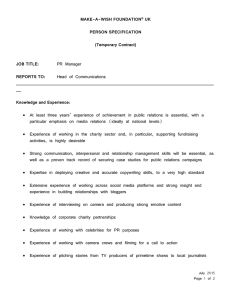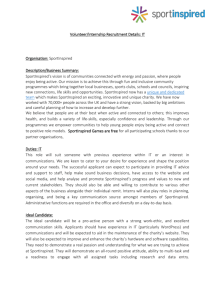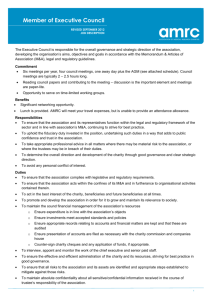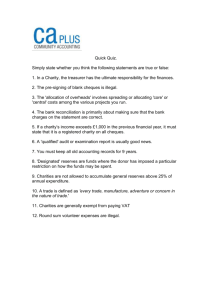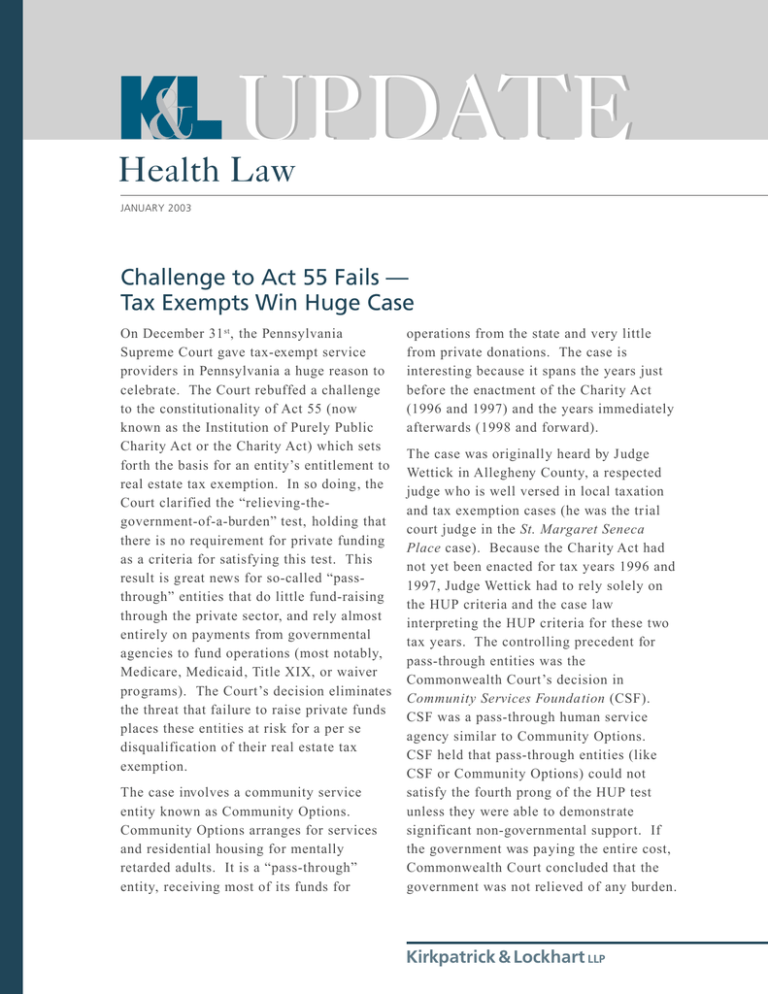
UPDATE
Health Law
JANUARY 2003
Challenge to Act 55 Fails —
Tax Exempts Win Huge Case
On December 31 st , the Pennsylvania
Supreme Court gave tax-exempt service
providers in Pennsylvania a huge reason to
celebrate. The Court rebuffed a challenge
to the constitutionality of Act 55 (now
known as the Institution of Purely Public
Charity Act or the Charity Act) which sets
forth the basis for an entity’s entitlement to
real estate tax exemption. In so doing, the
Court clarified the “relieving-thegovernment-of-a-burden” test, holding that
there is no requirement for private funding
as a criteria for satisfying this test. This
result is great news for so-called “passthrough” entities that do little fund-raising
through the private sector, and rely almost
entirely on payments from governmental
agencies to fund operations (most notably,
Medicare, Medicaid, Title XIX, or waiver
programs). The Court’s decision eliminates
the threat that failure to raise private funds
places these entities at risk for a per se
disqualification of their real estate tax
exemption.
The case involves a community service
entity known as Community Options.
Community Options arranges for services
and residential housing for mentally
retarded adults. It is a “pass-through”
entity, receiving most of its funds for
operations from the state and very little
from private donations. The case is
interesting because it spans the years just
before the enactment of the Charity Act
(1996 and 1997) and the years immediately
afterwards (1998 and forward).
The case was originally heard by Judge
Wettick in Allegheny County, a respected
judge who is well versed in local taxation
and tax exemption cases (he was the trial
court judge in the St. Margaret Seneca
Place case). Because the Charity Act had
not yet been enacted for tax years 1996 and
1997, Judge Wettick had to rely solely on
the HUP criteria and the case law
interpreting the HUP criteria for these two
tax years. The controlling precedent for
pass-through entities was the
Commonwealth Court’s decision in
Community Services Foundation (CSF).
CSF was a pass-through human service
agency similar to Community Options.
CSF held that pass-through entities (like
CSF or Community Options) could not
satisfy the fourth prong of the HUP test
unless they were able to demonstrate
significant non-governmental support. If
the government was paying the entire cost,
Commonwealth Court concluded that the
government was not relieved of any burden.
Kirkpatrick & Lockhart LLP
Because of CSF, the trial court had to rule
that Community Options was not exempt
for 1996 and 1997.
But for 1998 and thereafter, the trial court
found that the enactment of the Charity Act
changed the landscape. The Charity Act
established a series of quantitative tests
that Community Options satisfied. The
trial court was still faced with the dilemma
of reconciling the CSF case (which took a
more restrictive view of the fourth HUP
prong) against the Legislature’s
interpretation of the fourth prong in the
Charity Act. Judge Wettick found that
legislative codification of the fourth HUP
prong in the Charity Act was both proper
and constitutional. He further found that
Community Options met these tests and
was entitled to exemption for years 1998
and following.
In a lengthy and well-reasoned decision,
concluded that HUP and the Charity Act
were consistent and that the Charity Act’s
quantitative tests did not undercut or
conflict with HUP or the previous Supreme
Court interpretations of HUP. In other
words, the Charity Act was not
unconstitutional, even though in some
instances an entity could qualify under the
Act but not qualify under the pre-Act HUP
cases.
The trial court’s decision prompted the
question of how an entity could fail a
constitutional test in one year, but be
“saved” by a statute in the following year.
In other words, could a statute pre-empt a
constitutional test? This is an important
question because the section of the
Pennsylvania Constitution at issue only
permits the Legislature to exempt entities if
they are purely public charities, which
2
means that the Legislature has no power to
confer or create an exemption unless an
entity qualifies as a purely public charity in
the first instance. Observers have long
wondered whether satisfying the
quantitative tests set forth in the Charity
Act would automatically satisfy the
constitutional test (set forth in HUP) or
whether it would also be necessary to
independently satisfy both the constitution
(HUP) and the statutory (the Charity Act)
tests. Obviously, the Charity Act was
designed to mimick the HUP criteria and
establish quantitative and measurable
criteria to the open-ended and vague HUP
prongs. The preamble to the Charity Act
indicates that it was not intended to create
new or expansive exemption criteria.
The real issue underlying this appeal, of
course, is whether the Charity Act is
constitutional, i.e., do the Charity Act’s
quantitative tests pre-empt or modify the
Supreme Court’s HUP criteria or do they
merely implement them?
Both parties appealed to the Commonwealth
Court. The Commonwealth Court dodged
the issue of whether the Charity Act
conflicted with the HUP test and whether
the Legislature had the authority to enact
such a statute (in other words, was the
Charity Act constitutional). Instead, the
Court held that, because Community
Options (like CSF) had failed the fourth
prong of the HUP test before the Charity
Act’s enactment, it failed it for 1998 as
well. The Court viewed the HUP test as the
first step of the analysis and if the charity
could not pass that phase, it never had to
reach the second or statutory phase.
Consequently, it did not directly tackle the
constitutionality of the Charity Act.
KIRKPATRICK & LOCKHART LLP HEALTH LAW UPDATE
Community Options appealed to the
Supreme Court for 1998 and subsequent
years. It did not challenge its loss of
exemptions in 1996 and 1997 (which, with
the benefit of hindsight, is unfortunate
because it would have won for those years
as well).
The Supreme Court, by Justice Zappala,
dismissed the Commonwealth Court’s
interpretation of government burden. It
held that the test is not whether an entity is
fully funded by the government, but
whether the institution “bears a substantial
burden that would otherwise fall to the
government.” Using language aimed
directly at Commonwealth Court, the
Supreme Court held that there is not now,
nor has there ever been, a specific
threshold level of private funding as a
criteria for relieving the government of
some of its burden. The Court identified
numerous ways that an entity can relieve
the government’s burden including, as
examples, the compensation of its
employees, its fee structure, and whether
the cost to the government would be greater
if the charity’s activities were conducted by
the government itself.
The crux of the Court’s decision is its
recognition of the reality of how nonprofits
save the government time and money.
Nonprofits, in health care, mental health,
and education make it cheaper and easier
for the government to operate. Similar to
the “rent” or “buy” analysis in business, by
relying on a myriad of voluntary
nonprofits, the state is spared all the
operational risks and expenses of
conducting an enterprise itself. In effect, it
is renting the service rather than
duplicating it itself. By paying a “per
JANUARY 2003
diem,” the state’s only risk or concern is
funding the per diem payment. It is the
entity that faces all the problems and risks
of finding and training employees, finding
and maintaining facilities, finding and
training a board, and maintaining
operational solvency.
THE CHARITY ACT IS PRESERVED.
Importantly, the Court did not directly
examine or rule upon the constitutionality
of the Charity Act as the taxing jurisdiction
would have liked. Unlike the exhaustive
and scholarly analysis prepared by Judge
Wettick, the Supreme Court did not directly
address the constitutionality of the Charity
Act. In one sense, the argument of whether
an entity has to present evidence of
satisfying both HUP and the Charity Act is
still open. While the Court did not
affirmatively address the relationship
between HUP and the Charity Act, it made
it clear that HUP would not, in this
instance, be a bar to the application of the
Charity Act.
By confirming its analysis of the fourth
HUP prong, the Court endorsed a wider
view of nonprofits’ eligibility and at the
same time preserved the Charity Act. The
former is important because it prescribes a
more practical approach to satisfying the
HUP test, and the latter is important
because it preserves a statute that has
created relative peace and stability in the
previously contentious nonprofit versus tax
jurisdiction world.
WHAT DOES THIS MEAN?
There are at least two reasons for
nonprofits to be extremely happy with this
decision.
Kirkpatrick & Lockhart LLP
3
enlightened and realistic view of
voluntary agencies, the Court has (in
lockstep with the Legislature) clarified
the grounds for exemption. Even if the
constitutionality of the Charity Act is
subsequently challenged, the broader
view of relieving the government of a
burden remains intact.
1. While the Court did not rule on its
constitutionality, the Charity Act was not
compromised. If anything, challenges to
the Charity Act are likely to diminish.
The Court made it quite clear that it
supports the HUP—Charity Act template.
2. The Court adopted a practical and
holistic view of nonprofit “pass-through”
community service organizations. These
institutions and agencies play a vital and
indispensable role in the delivery of
health, education, and social services.
Without voluntary agencies, the state
simply could not provide the range,
depth, and quality of human social
services. By adopting the more
EDW
ARD V
EDWARD
V.. WEISGERBER
eweisgerber@kl.com
412.355.8980
FOR MORE INFORMATION, please contact the author or one of the following K&L lawyers:
Boston
R. Bruce Allensworth
Edward J. Brennan, Jr.
ballensworth@kl.com
ebrennan@kl.com
617.261.3119
617.951.9143
Harrisburg
Ruth E. Granfors
Raymond P. Pepe
rgranfors@kl.com
rpepe@kl.com
717.231.5835
717.231.5988
Miami
Marc H. Auerbach
William J. Spratt, Jr.
mauerbach@kl.com
wspratt@kl.com
305.539.3304
305.539.3320
Newark
Stephen A. Timoni
stimoni@kl.com
973.848.4020
Pittsburgh
Judy J. Hlafcsak
Edward V. Weisgerber
jhlafcsak@kl.com
eweisgerber@kl.com
412.355.8920
412.355.8980
Washington
Alan J. Berkeley
aberkeley@kl.com
202.778.9050
®
Kirkpatrick & Lockhart LLP
Challenge us. ®
www.kl.com
BOSTON
■
DALLAS
■
HARRISBURG
■
LOS ANGELES
■
MIAMI
■
NEWARK
■
NEW YORK
■
PITTSBURGH
■
SAN FRANCISCO
■
WASHINGTON
.........................................................................................................................................................
This publication/newsletter is for informational purposes and does not contain or convey legal advice. The information herein
should not be used or relied upon in regard to any particular facts or circumstances without first consulting a lawyer.
4
© 2003 KIRKPATRICK & LOCKHART LLP.
ALL RIGHTS RESERVED.

